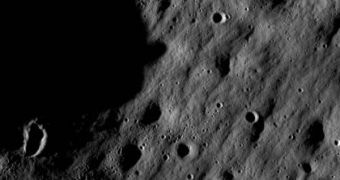Freshly arrived on the Moon's orbit just at the end of last month, NASA's Lunar Reconnaissance Orbiter (LRO) is not wasting any time standing idly around, and has already started photographing the lunar surface. It is, at this point, fulfilling two tasks – looking for resources, or potential places where to land future lunar missions, as well as mapping as much of the surface of the Earth's natural satellite as possible.
The two cameras aboard the probe, collectively known as the LRO Camera (LROC), have been brought online on June 30th, just seven days after the craft reached its destination, on June 23rd. For the new photo-shoot, which is the last direct American involvement with Moon exploration in about a decade, the instruments were pointed at a lunar region known as Mare Nubium (Sea of Clouds). Located in the Highlands, the area LROC focused on was a bit to the South of the sea, and the craft has seemingly already taken a liking in sitting above the surface, and watching the Moon spin beneath it.
“Our first images were taken along the moon's terminator – the dividing line between day and night – making us initially unsure of how they would turn out. Because of the deep shadowing, subtle topography is exaggerated, suggesting a craggy and inhospitable surface. In reality, the area is similar to the region where the Apollo 16 astronauts safely explored in 1972. While these are magnificent in their own right, the main message is that LROC is nearly ready to begin its mission,” Mark Robinson, who is the main LROC principal investigator, based out of Arizona State University, in Tempe, says.
The LRO will continue to make scientific observations of the lunar surface for as many years as possible. The main objective of its mission is to map as much of the surface as possible, both topographically and as far as composition goes. This has become extremely important of late, as the recently crashed Japanese space probe Kaguya has evidenced the fact that uranium exists on the lunar surface. With the new find, the prospect of a manned space mission to the Moon, such as the one NASA has planned for 2020, could become even more established, and maps of the potential landing area need to be flawless.

 14 DAY TRIAL //
14 DAY TRIAL //